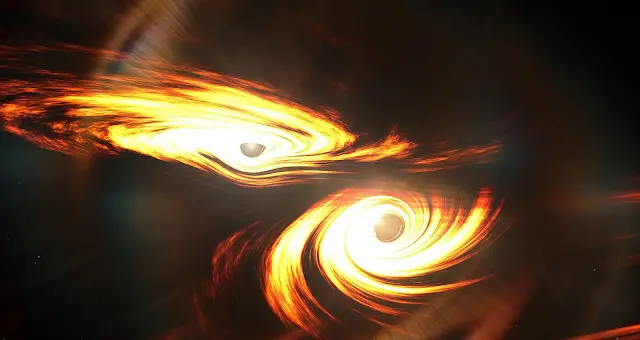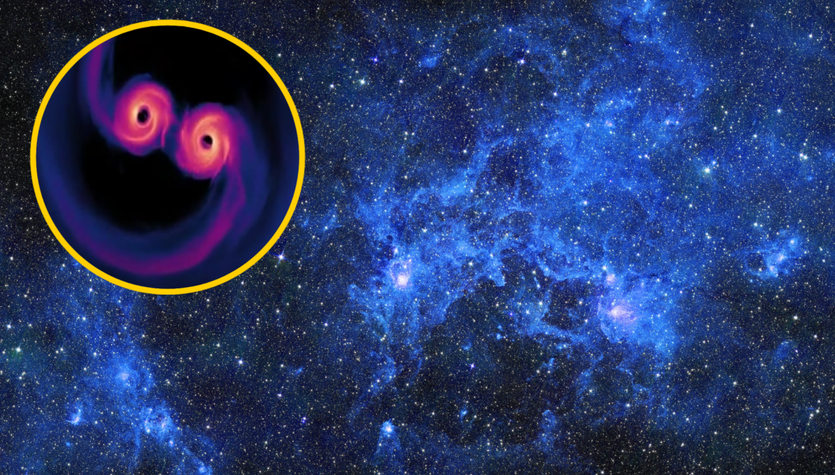Black holes are some of the most mysterious and fascinating objects in the universe. They are regions of space where gravity is so strong that nothing, not even light, can escape.

Table of Contents
But what happens when two black holes collide? And what if we could observe such a cosmic event from Earth?
In this article, we will explore the possibility of witnessing a historic black hole merger in three years, based on recent observations of a galaxy around a billion light years away. We will also explain what black hole mergers are, how they produce gravitational waves, and why they are important for our understanding of the nature and evolution of these enigmatic entities.

What are black hole mergers?
A black hole merger is a process in which two black holes orbit each other and gradually lose energy due to gravitational radiation. As they get closer and closer, they eventually merge into a single, larger black hole. This final stage of the merger is called a coalescence, and it releases a huge amount of energy in the form of gravitational waves.
Gravitational waves are ripples in the fabric of space-time that are caused by accelerating masses. They were predicted by Albert Einstein’s general theory of relativity in 1916, but they were not directly detected until 2015 by the Laser Interferometer Gravitational-Wave Observatory (LIGO) and the Virgo detector. Since then, dozens of gravitational wave events have been observed, mostly from binary black hole mergers.
However, most of the detected black hole mergers involve relatively small black holes, with masses ranging from a few to a few tens of times that of our Sun. These black holes produce gravitational waves in a frequency range that is accessible to LIGO and Virgo. But there is another class of black holes that are much more massive and elusive: supermassive black holes.
What are supermassive black holes?
Supermassive black holes are black holes with masses ranging from millions to billions of times that of our Sun. They are believed to exist at the centers of most galaxies, including our own Milky Way. They play a crucial role in shaping the structure and evolution of galaxies and their environments.
But how do supermassive black holes form and grow? One possible way is through the merger of smaller black holes, either from stellar evolution or from previous mergers. However, this scenario faces several challenges, such as how to bring two black holes close enough to merge in a reasonable time scale.
Another possible way is through the direct collapse of massive gas clouds in the early universe. However, this scenario also faces some difficulties, such as how to prevent the gas from fragmenting and forming stars instead.
Therefore, observing supermassive black hole mergers could help us test these different scenarios and learn more about the origin and growth of these colossal objects.
How can we observe supermassive black hole mergers?
Supermassive black hole mergers are expected to produce gravitational waves in a frequency range that is too low for LIGO and Virgo to detect. However, there are other ways to observe them indirectly.
One way is to look for electromagnetic signals that may accompany the merger. For example, if the merging black holes are surrounded by gas and dust, they may produce flares or jets of radiation that could be detected by telescopes across the electromagnetic spectrum.
Another way is to look for periodic variations in the brightness or spectrum of light coming from the center of a galaxy that hosts a binary supermassive black hole system. These variations could be caused by Doppler shifts or relativistic effects as the two black holes orbit each other.
Using these methods, astronomers have identified several candidates for binary supermassive black hole systems in different galaxies. However, none of them has been confirmed yet as a true merger event.
What is the case of SDSS J1430+2303?
SDSS J1430+2303 is a galaxy located about a billion light years away from Earth. It has been observed by several telescopes over the years, and it shows some unusual features that suggest it may host a binary supermassive black hole system at its core.
One of these features is a double-peaked emission line in its optical spectrum. This means that there are two sources of light emitting at slightly different wavelengths due to their relative motion. This could be explained by two orbiting black holes that are accreting gas from their surroundings.

